Taxation Law: Analysis of Mr. Smith's Residency and Capital Gains
VerifiedAdded on 2020/07/22
|7
|2286
|28
Report
AI Summary
This report analyzes the taxation implications for Mr. Smith, an Australian resident who worked in Hong Kong for a period and subsequently returned to Australia. The report examines his residency status based on common law and statutory tests, considering his income sources from employment, olive oil production, and asset sales (land, car, boat, and antique). It assesses capital gains arising from the sale of these assets, including the application of CGT events and exemptions for personal use assets. The analysis references relevant sections of the Income Tax Assessment Act 1997, providing a comprehensive overview of Mr. Smith's tax liabilities and the legal framework governing his financial activities. The report concludes that Mr. Smith is considered a resident of Australia for taxation purposes and is subject to capital gains tax on the sale of certain assets, such as the boat.
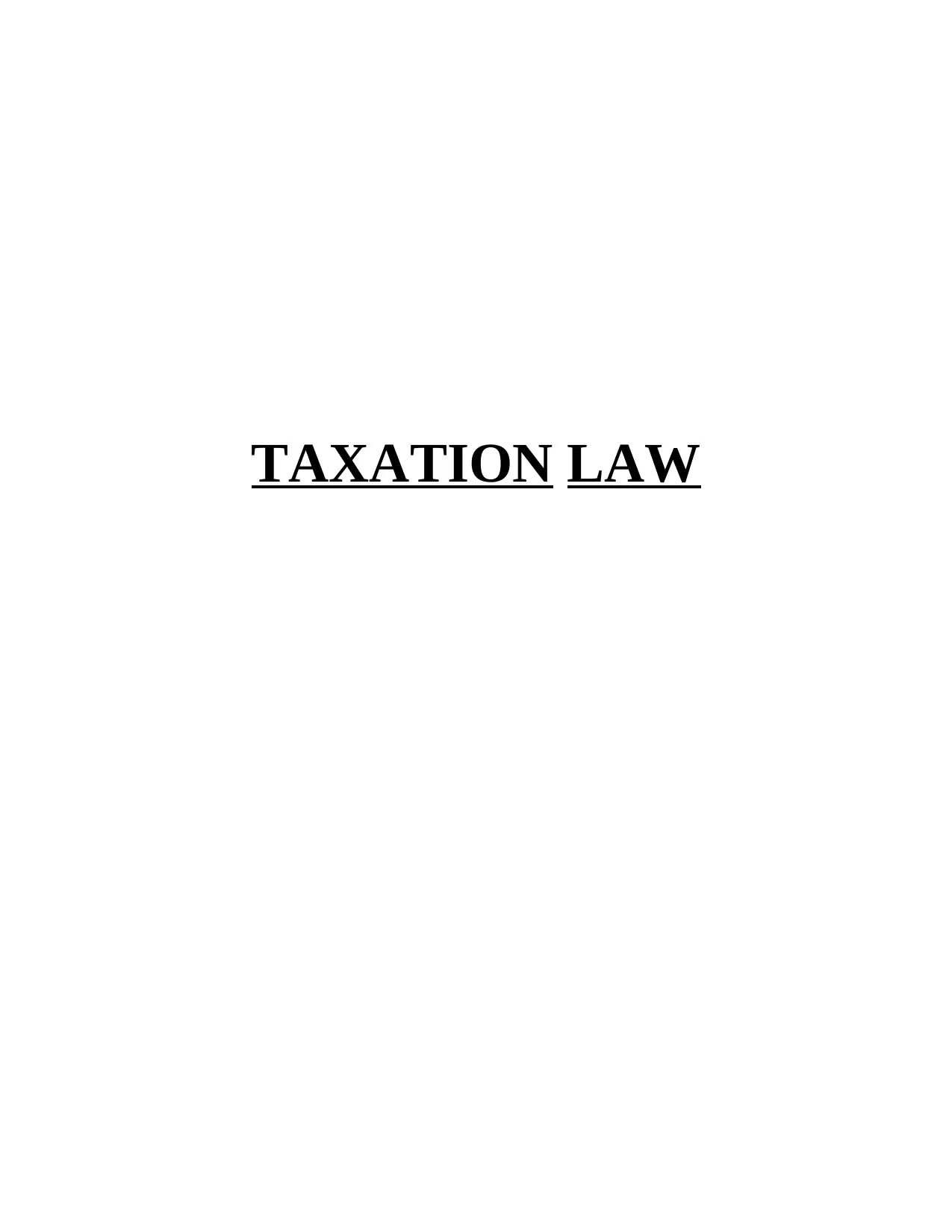
TAXATION LAW
Paraphrase This Document
Need a fresh take? Get an instant paraphrase of this document with our AI Paraphraser
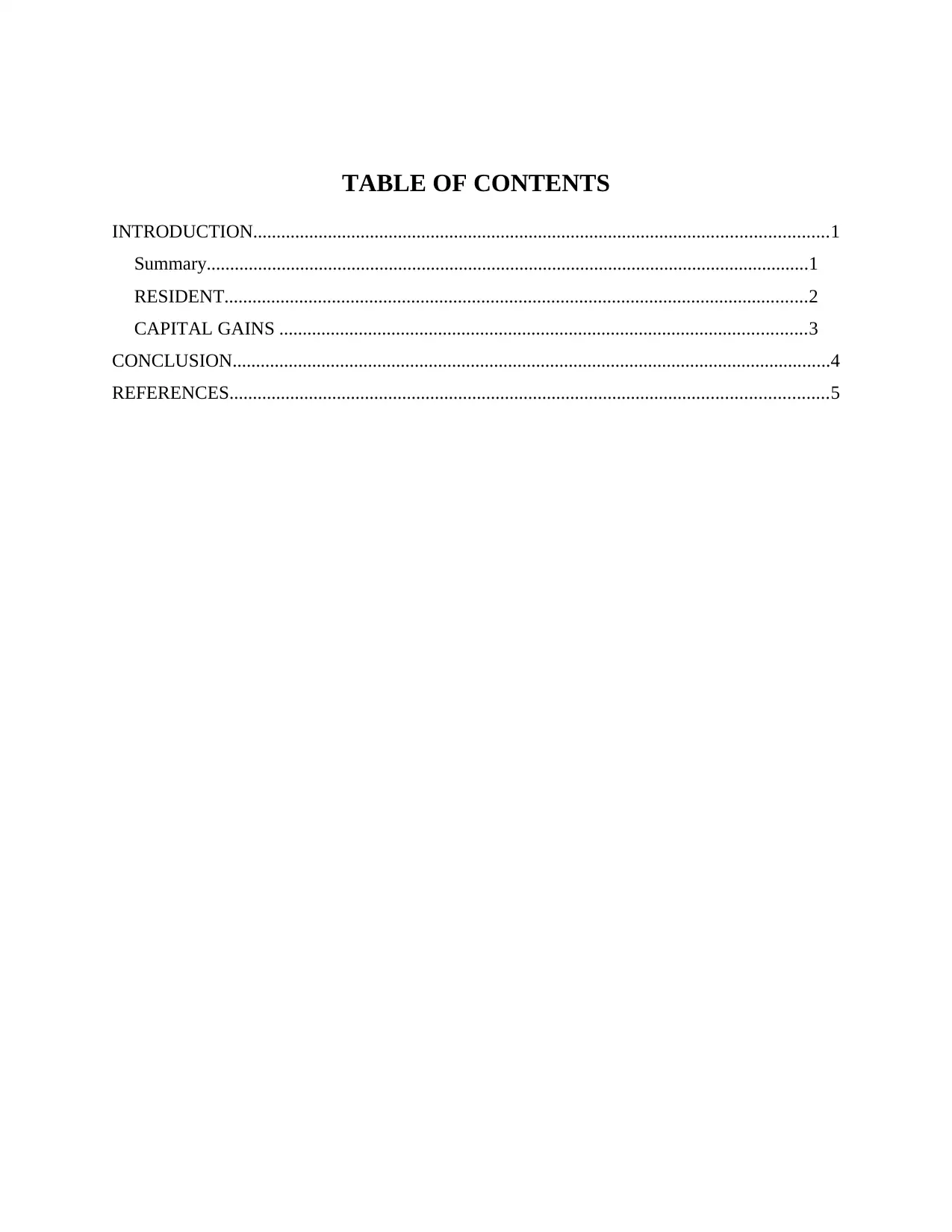
TABLE OF CONTENTS
INTRODUCTION...........................................................................................................................1
Summary.................................................................................................................................1
RESIDENT.............................................................................................................................2
CAPITAL GAINS .................................................................................................................3
CONCLUSION................................................................................................................................4
REFERENCES................................................................................................................................5
INTRODUCTION...........................................................................................................................1
Summary.................................................................................................................................1
RESIDENT.............................................................................................................................2
CAPITAL GAINS .................................................................................................................3
CONCLUSION................................................................................................................................4
REFERENCES................................................................................................................................5
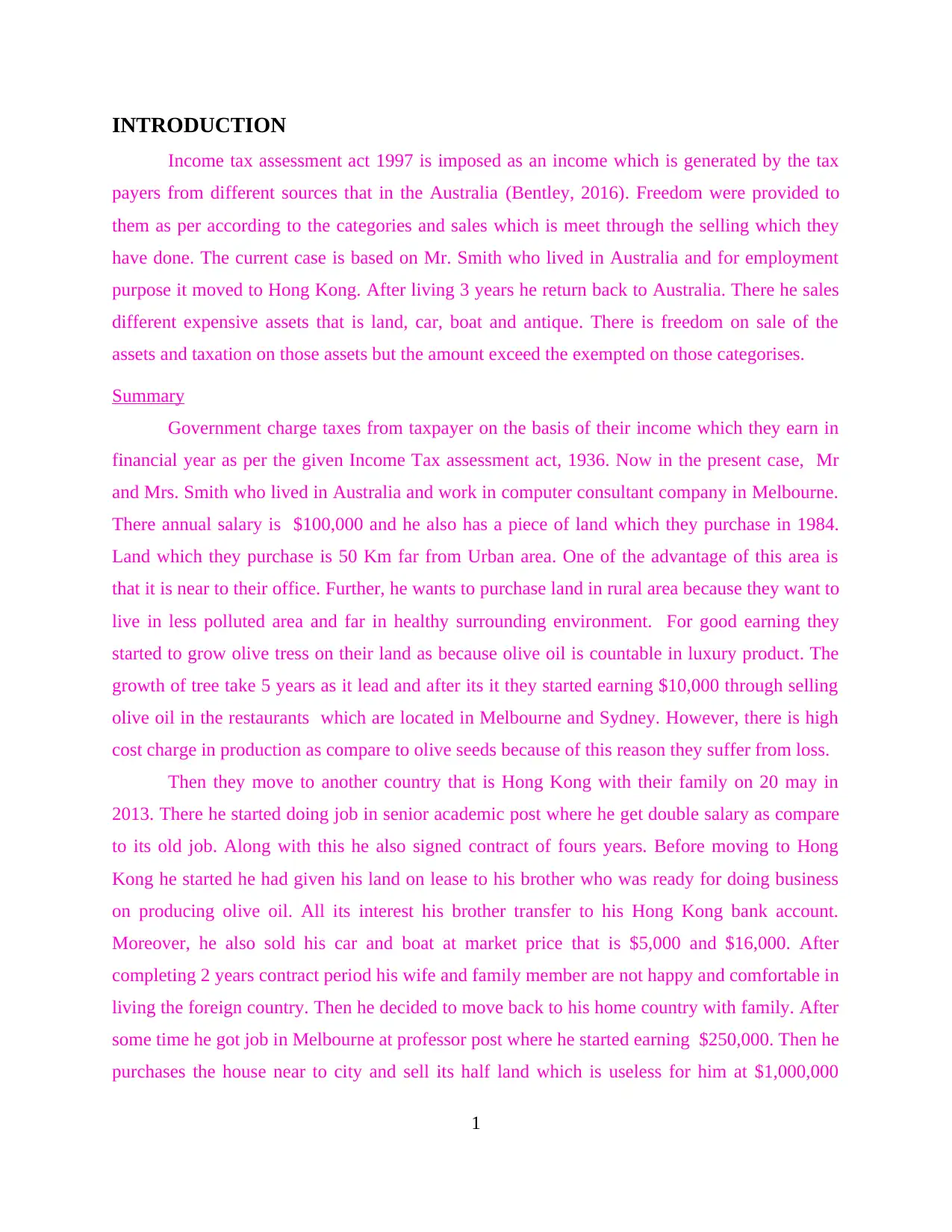
INTRODUCTION
Income tax assessment act 1997 is imposed as an income which is generated by the tax
payers from different sources that in the Australia (Bentley, 2016). Freedom were provided to
them as per according to the categories and sales which is meet through the selling which they
have done. The current case is based on Mr. Smith who lived in Australia and for employment
purpose it moved to Hong Kong. After living 3 years he return back to Australia. There he sales
different expensive assets that is land, car, boat and antique. There is freedom on sale of the
assets and taxation on those assets but the amount exceed the exempted on those categorises.
Summary
Government charge taxes from taxpayer on the basis of their income which they earn in
financial year as per the given Income Tax assessment act, 1936. Now in the present case, Mr
and Mrs. Smith who lived in Australia and work in computer consultant company in Melbourne.
There annual salary is $100,000 and he also has a piece of land which they purchase in 1984.
Land which they purchase is 50 Km far from Urban area. One of the advantage of this area is
that it is near to their office. Further, he wants to purchase land in rural area because they want to
live in less polluted area and far in healthy surrounding environment. For good earning they
started to grow olive tress on their land as because olive oil is countable in luxury product. The
growth of tree take 5 years as it lead and after its it they started earning $10,000 through selling
olive oil in the restaurants which are located in Melbourne and Sydney. However, there is high
cost charge in production as compare to olive seeds because of this reason they suffer from loss.
Then they move to another country that is Hong Kong with their family on 20 may in
2013. There he started doing job in senior academic post where he get double salary as compare
to its old job. Along with this he also signed contract of fours years. Before moving to Hong
Kong he started he had given his land on lease to his brother who was ready for doing business
on producing olive oil. All its interest his brother transfer to his Hong Kong bank account.
Moreover, he also sold his car and boat at market price that is $5,000 and $16,000. After
completing 2 years contract period his wife and family member are not happy and comfortable in
living the foreign country. Then he decided to move back to his home country with family. After
some time he got job in Melbourne at professor post where he started earning $250,000. Then he
purchases the house near to city and sell its half land which is useless for him at $1,000,000
1
Income tax assessment act 1997 is imposed as an income which is generated by the tax
payers from different sources that in the Australia (Bentley, 2016). Freedom were provided to
them as per according to the categories and sales which is meet through the selling which they
have done. The current case is based on Mr. Smith who lived in Australia and for employment
purpose it moved to Hong Kong. After living 3 years he return back to Australia. There he sales
different expensive assets that is land, car, boat and antique. There is freedom on sale of the
assets and taxation on those assets but the amount exceed the exempted on those categorises.
Summary
Government charge taxes from taxpayer on the basis of their income which they earn in
financial year as per the given Income Tax assessment act, 1936. Now in the present case, Mr
and Mrs. Smith who lived in Australia and work in computer consultant company in Melbourne.
There annual salary is $100,000 and he also has a piece of land which they purchase in 1984.
Land which they purchase is 50 Km far from Urban area. One of the advantage of this area is
that it is near to their office. Further, he wants to purchase land in rural area because they want to
live in less polluted area and far in healthy surrounding environment. For good earning they
started to grow olive tress on their land as because olive oil is countable in luxury product. The
growth of tree take 5 years as it lead and after its it they started earning $10,000 through selling
olive oil in the restaurants which are located in Melbourne and Sydney. However, there is high
cost charge in production as compare to olive seeds because of this reason they suffer from loss.
Then they move to another country that is Hong Kong with their family on 20 may in
2013. There he started doing job in senior academic post where he get double salary as compare
to its old job. Along with this he also signed contract of fours years. Before moving to Hong
Kong he started he had given his land on lease to his brother who was ready for doing business
on producing olive oil. All its interest his brother transfer to his Hong Kong bank account.
Moreover, he also sold his car and boat at market price that is $5,000 and $16,000. After
completing 2 years contract period his wife and family member are not happy and comfortable in
living the foreign country. Then he decided to move back to his home country with family. After
some time he got job in Melbourne at professor post where he started earning $250,000. Then he
purchases the house near to city and sell its half land which is useless for him at $1,000,000
1
⊘ This is a preview!⊘
Do you want full access?
Subscribe today to unlock all pages.

Trusted by 1+ million students worldwide
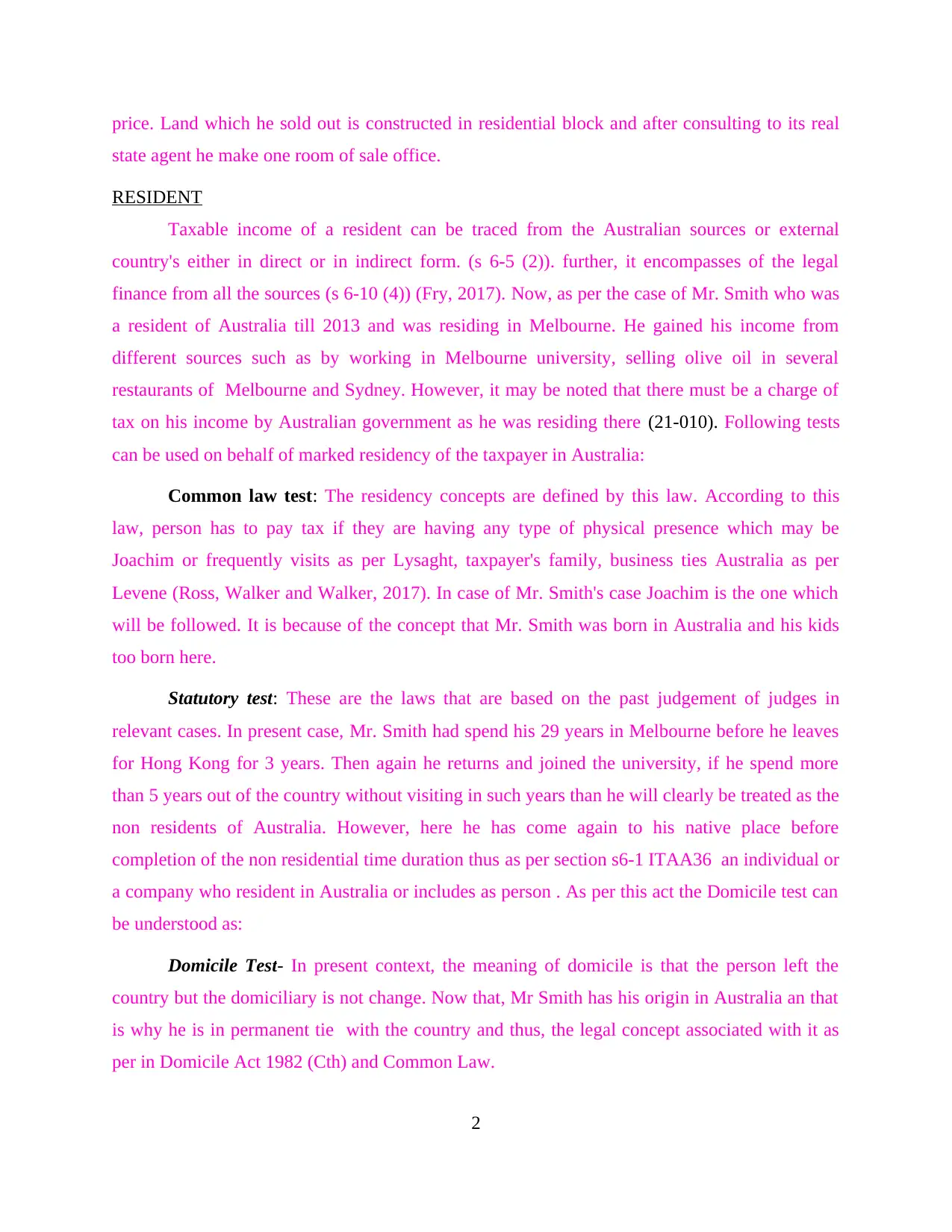
price. Land which he sold out is constructed in residential block and after consulting to its real
state agent he make one room of sale office.
RESIDENT
Taxable income of a resident can be traced from the Australian sources or external
country's either in direct or in indirect form. (s 6-5 (2)). further, it encompasses of the legal
finance from all the sources (s 6-10 (4)) (Fry, 2017). Now, as per the case of Mr. Smith who was
a resident of Australia till 2013 and was residing in Melbourne. He gained his income from
different sources such as by working in Melbourne university, selling olive oil in several
restaurants of Melbourne and Sydney. However, it may be noted that there must be a charge of
tax on his income by Australian government as he was residing there (21-010). Following tests
can be used on behalf of marked residency of the taxpayer in Australia:
Common law test: The residency concepts are defined by this law. According to this
law, person has to pay tax if they are having any type of physical presence which may be
Joachim or frequently visits as per Lysaght, taxpayer's family, business ties Australia as per
Levene (Ross, Walker and Walker, 2017). In case of Mr. Smith's case Joachim is the one which
will be followed. It is because of the concept that Mr. Smith was born in Australia and his kids
too born here.
Statutory test: These are the laws that are based on the past judgement of judges in
relevant cases. In present case, Mr. Smith had spend his 29 years in Melbourne before he leaves
for Hong Kong for 3 years. Then again he returns and joined the university, if he spend more
than 5 years out of the country without visiting in such years than he will clearly be treated as the
non residents of Australia. However, here he has come again to his native place before
completion of the non residential time duration thus as per section s6-1 ITAA36 an individual or
a company who resident in Australia or includes as person . As per this act the Domicile test can
be understood as:
Domicile Test- In present context, the meaning of domicile is that the person left the
country but the domiciliary is not change. Now that, Mr Smith has his origin in Australia an that
is why he is in permanent tie with the country and thus, the legal concept associated with it as
per in Domicile Act 1982 (Cth) and Common Law.
2
state agent he make one room of sale office.
RESIDENT
Taxable income of a resident can be traced from the Australian sources or external
country's either in direct or in indirect form. (s 6-5 (2)). further, it encompasses of the legal
finance from all the sources (s 6-10 (4)) (Fry, 2017). Now, as per the case of Mr. Smith who was
a resident of Australia till 2013 and was residing in Melbourne. He gained his income from
different sources such as by working in Melbourne university, selling olive oil in several
restaurants of Melbourne and Sydney. However, it may be noted that there must be a charge of
tax on his income by Australian government as he was residing there (21-010). Following tests
can be used on behalf of marked residency of the taxpayer in Australia:
Common law test: The residency concepts are defined by this law. According to this
law, person has to pay tax if they are having any type of physical presence which may be
Joachim or frequently visits as per Lysaght, taxpayer's family, business ties Australia as per
Levene (Ross, Walker and Walker, 2017). In case of Mr. Smith's case Joachim is the one which
will be followed. It is because of the concept that Mr. Smith was born in Australia and his kids
too born here.
Statutory test: These are the laws that are based on the past judgement of judges in
relevant cases. In present case, Mr. Smith had spend his 29 years in Melbourne before he leaves
for Hong Kong for 3 years. Then again he returns and joined the university, if he spend more
than 5 years out of the country without visiting in such years than he will clearly be treated as the
non residents of Australia. However, here he has come again to his native place before
completion of the non residential time duration thus as per section s6-1 ITAA36 an individual or
a company who resident in Australia or includes as person . As per this act the Domicile test can
be understood as:
Domicile Test- In present context, the meaning of domicile is that the person left the
country but the domiciliary is not change. Now that, Mr Smith has his origin in Australia an that
is why he is in permanent tie with the country and thus, the legal concept associated with it as
per in Domicile Act 1982 (Cth) and Common Law.
2
Paraphrase This Document
Need a fresh take? Get an instant paraphrase of this document with our AI Paraphraser
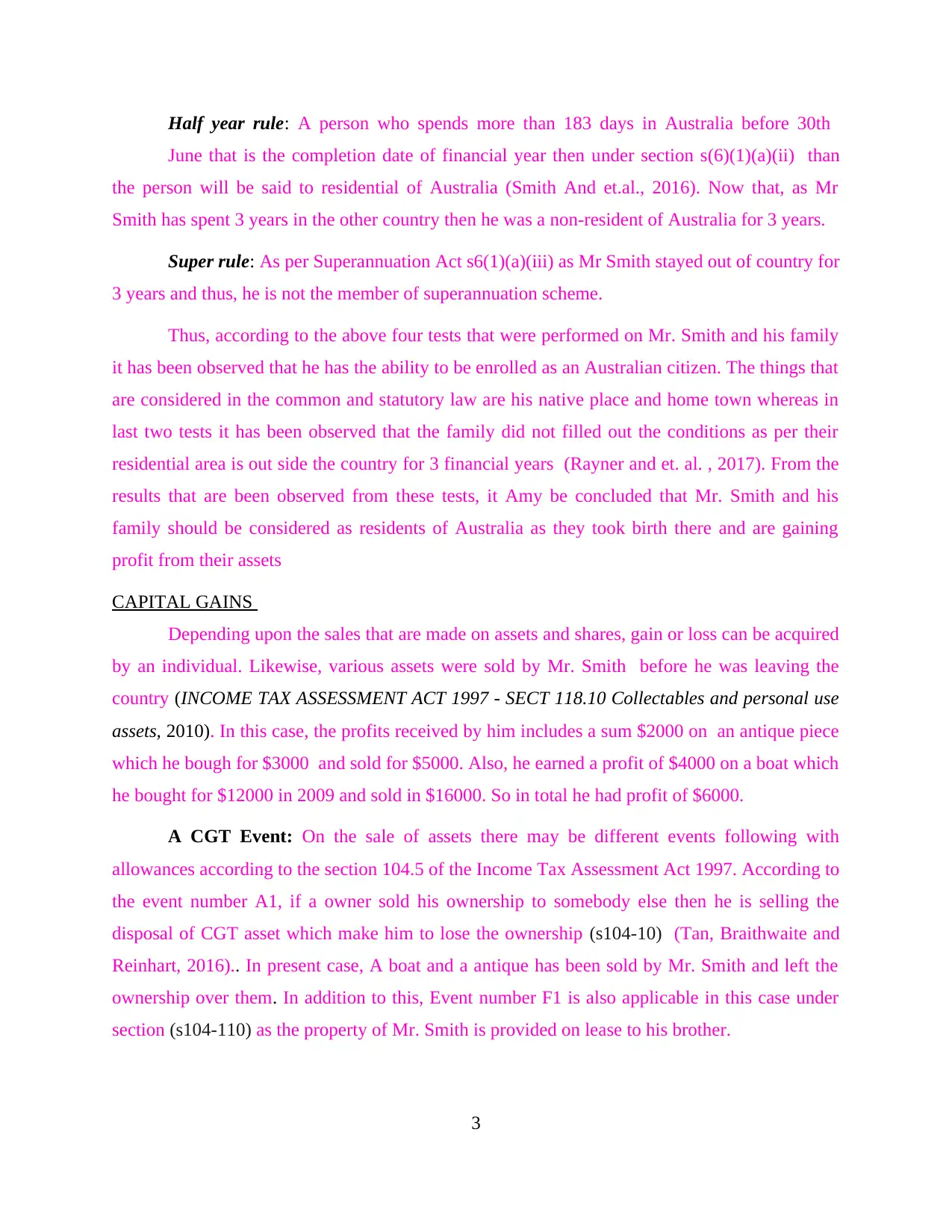
Half year rule: A person who spends more than 183 days in Australia before 30th
June that is the completion date of financial year then under section s(6)(1)(a)(ii) than
the person will be said to residential of Australia (Smith And et.al., 2016). Now that, as Mr
Smith has spent 3 years in the other country then he was a non-resident of Australia for 3 years.
Super rule: As per Superannuation Act s6(1)(a)(iii) as Mr Smith stayed out of country for
3 years and thus, he is not the member of superannuation scheme.
Thus, according to the above four tests that were performed on Mr. Smith and his family
it has been observed that he has the ability to be enrolled as an Australian citizen. The things that
are considered in the common and statutory law are his native place and home town whereas in
last two tests it has been observed that the family did not filled out the conditions as per their
residential area is out side the country for 3 financial years (Rayner and et. al. , 2017). From the
results that are been observed from these tests, it Amy be concluded that Mr. Smith and his
family should be considered as residents of Australia as they took birth there and are gaining
profit from their assets
CAPITAL GAINS
Depending upon the sales that are made on assets and shares, gain or loss can be acquired
by an individual. Likewise, various assets were sold by Mr. Smith before he was leaving the
country (INCOME TAX ASSESSMENT ACT 1997 - SECT 118.10 Collectables and personal use
assets, 2010). In this case, the profits received by him includes a sum $2000 on an antique piece
which he bough for $3000 and sold for $5000. Also, he earned a profit of $4000 on a boat which
he bought for $12000 in 2009 and sold in $16000. So in total he had profit of $6000.
A CGT Event: On the sale of assets there may be different events following with
allowances according to the section 104.5 of the Income Tax Assessment Act 1997. According to
the event number A1, if a owner sold his ownership to somebody else then he is selling the
disposal of CGT asset which make him to lose the ownership (s104-10) (Tan, Braithwaite and
Reinhart, 2016).. In present case, A boat and a antique has been sold by Mr. Smith and left the
ownership over them. In addition to this, Event number F1 is also applicable in this case under
section (s104-110) as the property of Mr. Smith is provided on lease to his brother.
3
June that is the completion date of financial year then under section s(6)(1)(a)(ii) than
the person will be said to residential of Australia (Smith And et.al., 2016). Now that, as Mr
Smith has spent 3 years in the other country then he was a non-resident of Australia for 3 years.
Super rule: As per Superannuation Act s6(1)(a)(iii) as Mr Smith stayed out of country for
3 years and thus, he is not the member of superannuation scheme.
Thus, according to the above four tests that were performed on Mr. Smith and his family
it has been observed that he has the ability to be enrolled as an Australian citizen. The things that
are considered in the common and statutory law are his native place and home town whereas in
last two tests it has been observed that the family did not filled out the conditions as per their
residential area is out side the country for 3 financial years (Rayner and et. al. , 2017). From the
results that are been observed from these tests, it Amy be concluded that Mr. Smith and his
family should be considered as residents of Australia as they took birth there and are gaining
profit from their assets
CAPITAL GAINS
Depending upon the sales that are made on assets and shares, gain or loss can be acquired
by an individual. Likewise, various assets were sold by Mr. Smith before he was leaving the
country (INCOME TAX ASSESSMENT ACT 1997 - SECT 118.10 Collectables and personal use
assets, 2010). In this case, the profits received by him includes a sum $2000 on an antique piece
which he bough for $3000 and sold for $5000. Also, he earned a profit of $4000 on a boat which
he bought for $12000 in 2009 and sold in $16000. So in total he had profit of $6000.
A CGT Event: On the sale of assets there may be different events following with
allowances according to the section 104.5 of the Income Tax Assessment Act 1997. According to
the event number A1, if a owner sold his ownership to somebody else then he is selling the
disposal of CGT asset which make him to lose the ownership (s104-10) (Tan, Braithwaite and
Reinhart, 2016).. In present case, A boat and a antique has been sold by Mr. Smith and left the
ownership over them. In addition to this, Event number F1 is also applicable in this case under
section (s104-110) as the property of Mr. Smith is provided on lease to his brother.
3
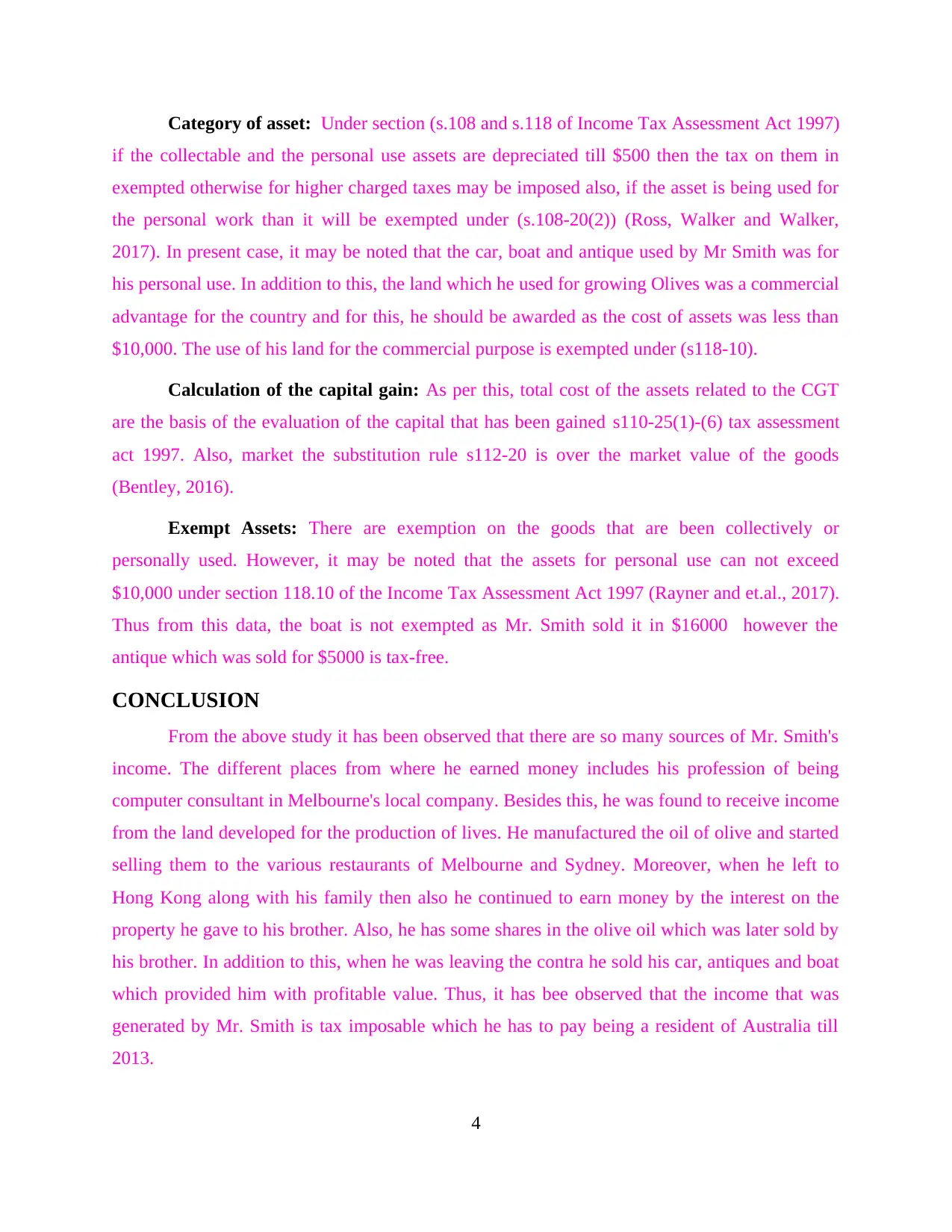
Category of asset: Under section (s.108 and s.118 of Income Tax Assessment Act 1997)
if the collectable and the personal use assets are depreciated till $500 then the tax on them in
exempted otherwise for higher charged taxes may be imposed also, if the asset is being used for
the personal work than it will be exempted under (s.108-20(2)) (Ross, Walker and Walker,
2017). In present case, it may be noted that the car, boat and antique used by Mr Smith was for
his personal use. In addition to this, the land which he used for growing Olives was a commercial
advantage for the country and for this, he should be awarded as the cost of assets was less than
$10,000. The use of his land for the commercial purpose is exempted under (s118-10).
Calculation of the capital gain: As per this, total cost of the assets related to the CGT
are the basis of the evaluation of the capital that has been gained s110-25(1)-(6) tax assessment
act 1997. Also, market the substitution rule s112-20 is over the market value of the goods
(Bentley, 2016).
Exempt Assets: There are exemption on the goods that are been collectively or
personally used. However, it may be noted that the assets for personal use can not exceed
$10,000 under section 118.10 of the Income Tax Assessment Act 1997 (Rayner and et.al., 2017).
Thus from this data, the boat is not exempted as Mr. Smith sold it in $16000 however the
antique which was sold for $5000 is tax-free.
CONCLUSION
From the above study it has been observed that there are so many sources of Mr. Smith's
income. The different places from where he earned money includes his profession of being
computer consultant in Melbourne's local company. Besides this, he was found to receive income
from the land developed for the production of lives. He manufactured the oil of olive and started
selling them to the various restaurants of Melbourne and Sydney. Moreover, when he left to
Hong Kong along with his family then also he continued to earn money by the interest on the
property he gave to his brother. Also, he has some shares in the olive oil which was later sold by
his brother. In addition to this, when he was leaving the contra he sold his car, antiques and boat
which provided him with profitable value. Thus, it has bee observed that the income that was
generated by Mr. Smith is tax imposable which he has to pay being a resident of Australia till
2013.
4
if the collectable and the personal use assets are depreciated till $500 then the tax on them in
exempted otherwise for higher charged taxes may be imposed also, if the asset is being used for
the personal work than it will be exempted under (s.108-20(2)) (Ross, Walker and Walker,
2017). In present case, it may be noted that the car, boat and antique used by Mr Smith was for
his personal use. In addition to this, the land which he used for growing Olives was a commercial
advantage for the country and for this, he should be awarded as the cost of assets was less than
$10,000. The use of his land for the commercial purpose is exempted under (s118-10).
Calculation of the capital gain: As per this, total cost of the assets related to the CGT
are the basis of the evaluation of the capital that has been gained s110-25(1)-(6) tax assessment
act 1997. Also, market the substitution rule s112-20 is over the market value of the goods
(Bentley, 2016).
Exempt Assets: There are exemption on the goods that are been collectively or
personally used. However, it may be noted that the assets for personal use can not exceed
$10,000 under section 118.10 of the Income Tax Assessment Act 1997 (Rayner and et.al., 2017).
Thus from this data, the boat is not exempted as Mr. Smith sold it in $16000 however the
antique which was sold for $5000 is tax-free.
CONCLUSION
From the above study it has been observed that there are so many sources of Mr. Smith's
income. The different places from where he earned money includes his profession of being
computer consultant in Melbourne's local company. Besides this, he was found to receive income
from the land developed for the production of lives. He manufactured the oil of olive and started
selling them to the various restaurants of Melbourne and Sydney. Moreover, when he left to
Hong Kong along with his family then also he continued to earn money by the interest on the
property he gave to his brother. Also, he has some shares in the olive oil which was later sold by
his brother. In addition to this, when he was leaving the contra he sold his car, antiques and boat
which provided him with profitable value. Thus, it has bee observed that the income that was
generated by Mr. Smith is tax imposable which he has to pay being a resident of Australia till
2013.
4
⊘ This is a preview!⊘
Do you want full access?
Subscribe today to unlock all pages.

Trusted by 1+ million students worldwide
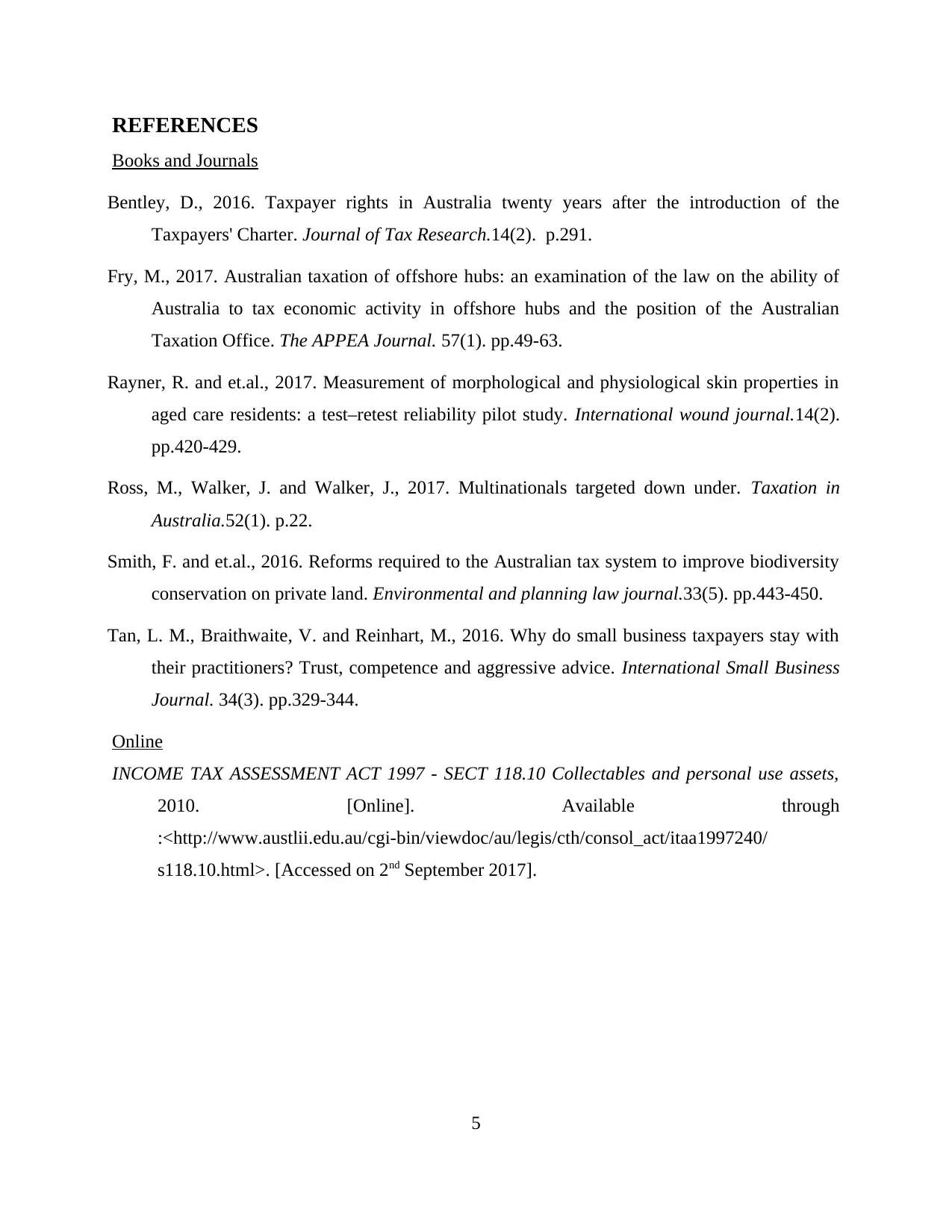
REFERENCES
Books and Journals
Bentley, D., 2016. Taxpayer rights in Australia twenty years after the introduction of the
Taxpayers' Charter. Journal of Tax Research.14(2). p.291.
Fry, M., 2017. Australian taxation of offshore hubs: an examination of the law on the ability of
Australia to tax economic activity in offshore hubs and the position of the Australian
Taxation Office. The APPEA Journal. 57(1). pp.49-63.
Rayner, R. and et.al., 2017. Measurement of morphological and physiological skin properties in
aged care residents: a test–retest reliability pilot study. International wound journal.14(2).
pp.420-429.
Ross, M., Walker, J. and Walker, J., 2017. Multinationals targeted down under. Taxation in
Australia.52(1). p.22.
Smith, F. and et.al., 2016. Reforms required to the Australian tax system to improve biodiversity
conservation on private land. Environmental and planning law journal.33(5). pp.443-450.
Tan, L. M., Braithwaite, V. and Reinhart, M., 2016. Why do small business taxpayers stay with
their practitioners? Trust, competence and aggressive advice. International Small Business
Journal. 34(3). pp.329-344.
Online
INCOME TAX ASSESSMENT ACT 1997 - SECT 118.10 Collectables and personal use assets,
2010. [Online]. Available through
:<http://www.austlii.edu.au/cgi-bin/viewdoc/au/legis/cth/consol_act/itaa1997240/
s118.10.html>. [Accessed on 2nd September 2017].
5
Books and Journals
Bentley, D., 2016. Taxpayer rights in Australia twenty years after the introduction of the
Taxpayers' Charter. Journal of Tax Research.14(2). p.291.
Fry, M., 2017. Australian taxation of offshore hubs: an examination of the law on the ability of
Australia to tax economic activity in offshore hubs and the position of the Australian
Taxation Office. The APPEA Journal. 57(1). pp.49-63.
Rayner, R. and et.al., 2017. Measurement of morphological and physiological skin properties in
aged care residents: a test–retest reliability pilot study. International wound journal.14(2).
pp.420-429.
Ross, M., Walker, J. and Walker, J., 2017. Multinationals targeted down under. Taxation in
Australia.52(1). p.22.
Smith, F. and et.al., 2016. Reforms required to the Australian tax system to improve biodiversity
conservation on private land. Environmental and planning law journal.33(5). pp.443-450.
Tan, L. M., Braithwaite, V. and Reinhart, M., 2016. Why do small business taxpayers stay with
their practitioners? Trust, competence and aggressive advice. International Small Business
Journal. 34(3). pp.329-344.
Online
INCOME TAX ASSESSMENT ACT 1997 - SECT 118.10 Collectables and personal use assets,
2010. [Online]. Available through
:<http://www.austlii.edu.au/cgi-bin/viewdoc/au/legis/cth/consol_act/itaa1997240/
s118.10.html>. [Accessed on 2nd September 2017].
5
1 out of 7
Related Documents
Your All-in-One AI-Powered Toolkit for Academic Success.
+13062052269
info@desklib.com
Available 24*7 on WhatsApp / Email
![[object Object]](/_next/static/media/star-bottom.7253800d.svg)
Unlock your academic potential
Copyright © 2020–2025 A2Z Services. All Rights Reserved. Developed and managed by ZUCOL.





